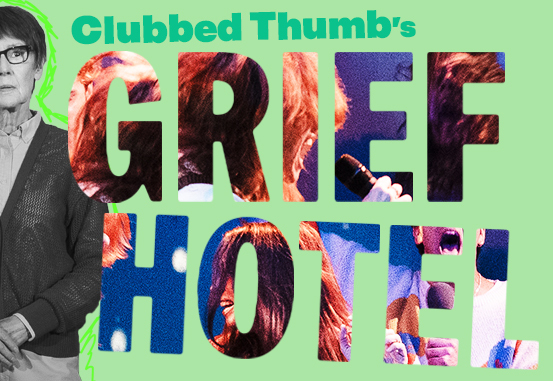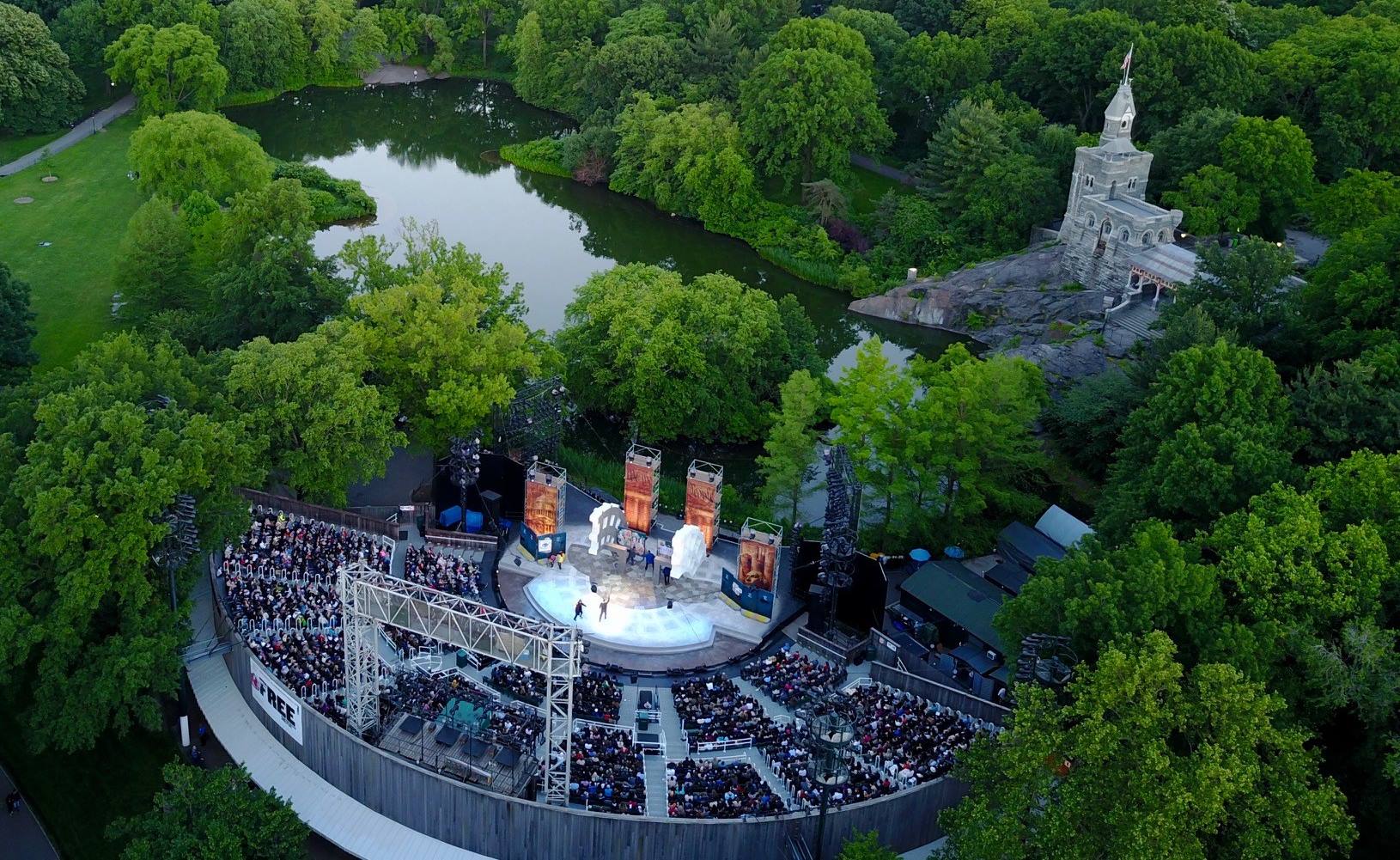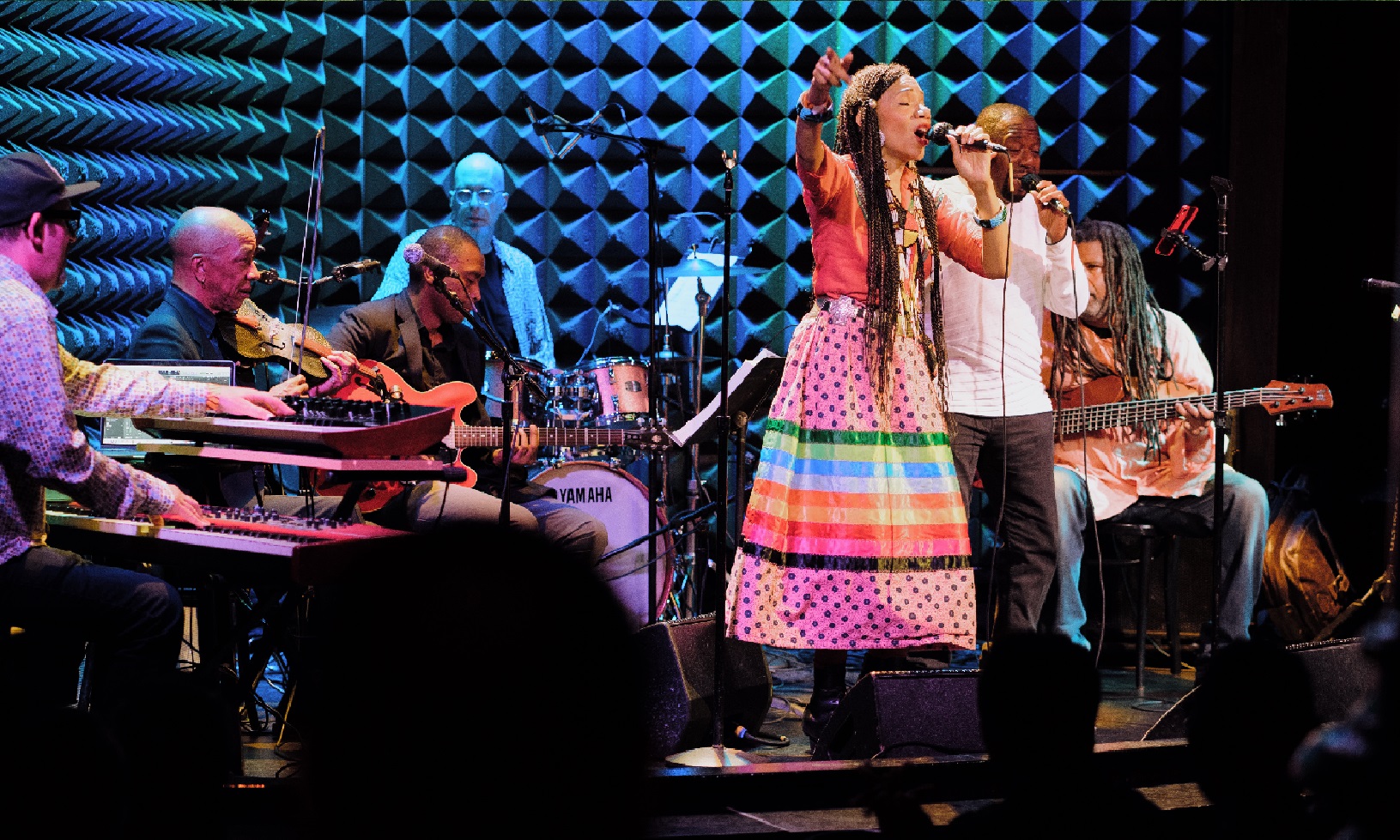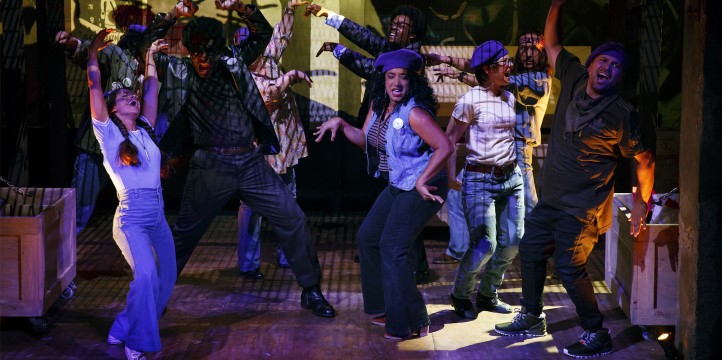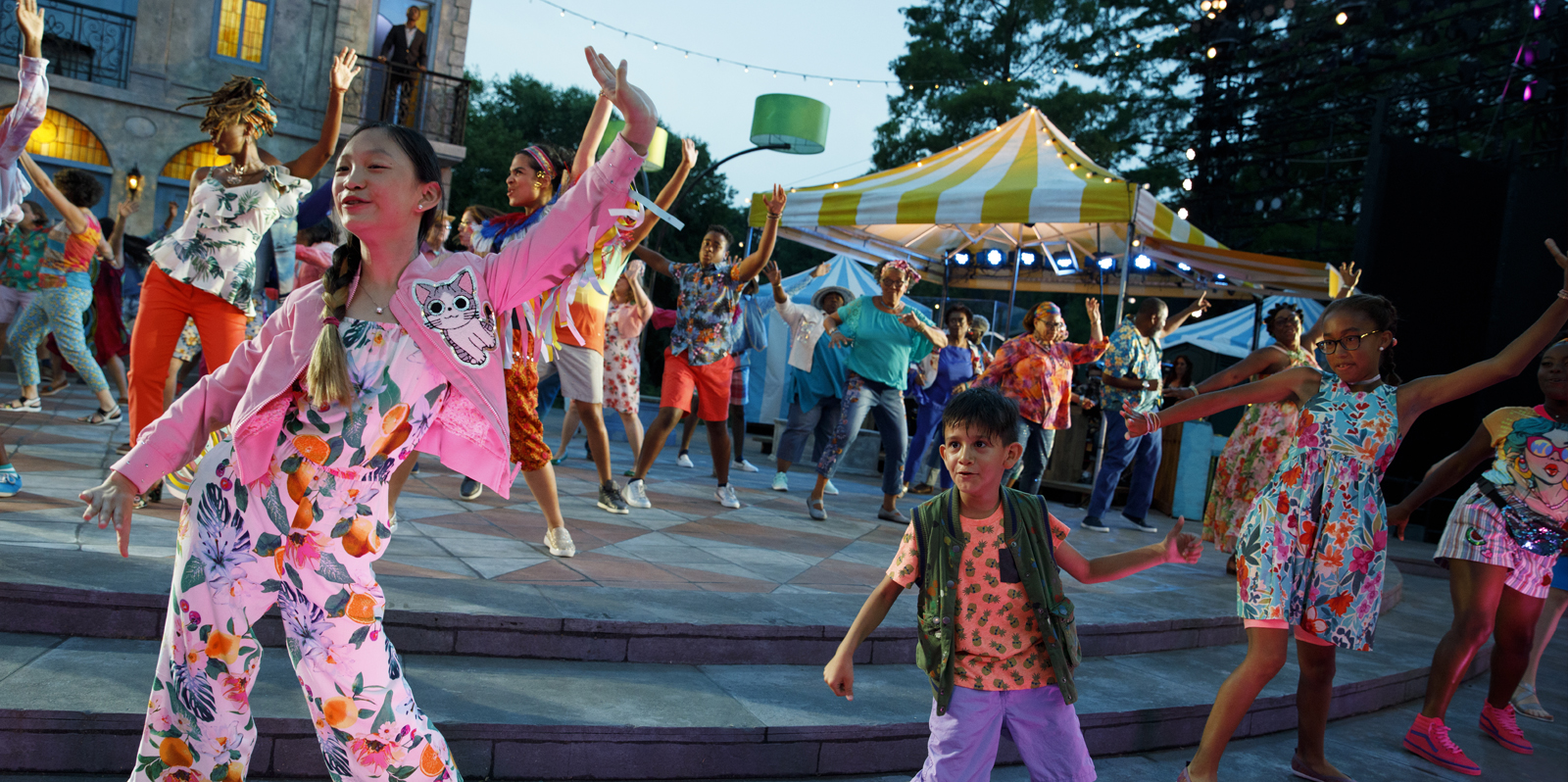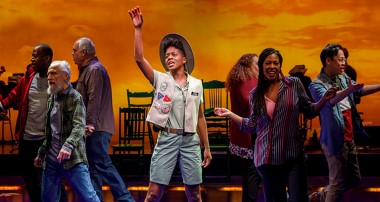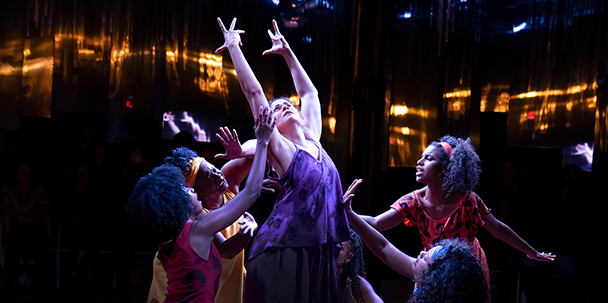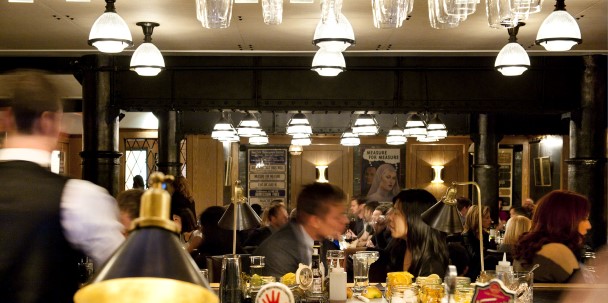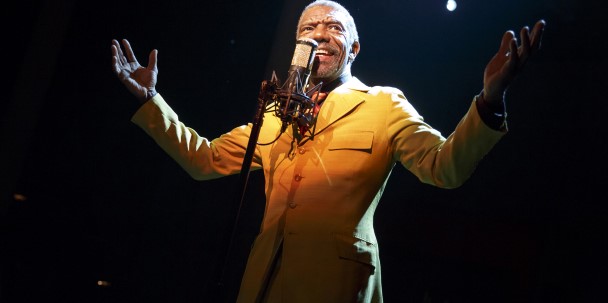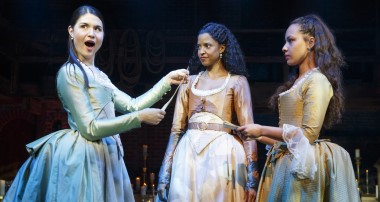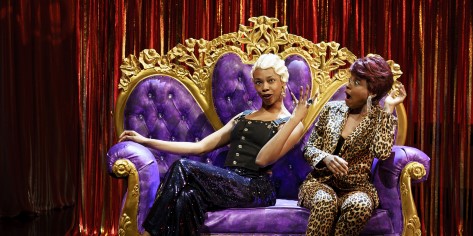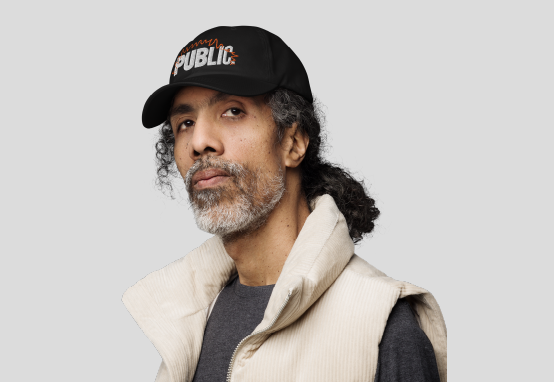Fernando Masterson: In 1954, a man named Joe Papp decided to bring free performances of Shakespeare to the people of New York. He toured the parks across the city, eventually ending up in Central Park and on Aster Place.
Reynaldi Lindner Lolong: But that was just the beginning. What began as summertime Shakespeare in neighborhood parks has since blossomed into a year-round hub of culture, featuring new plays and musicals, live music, international performance art, cabaret, community dialogue, civic engagement, and of course, Shakespeare.
FM: Through it all, the impulse has remained the same: to be a theater that is of, by, and for all people. Welcome to Public Square, a podcast of The Public Theater.
FM: Hi, Reynaldi.
RLL: Hey, Fern.
FM: Happy New Year!
RLL: Yeah, like—
[laughter]
FM: Well, I guess we’re in February. Happy February!
RLL: January just kind of came and went, but I guess like, it was basically taken up entirely by the Under the Radar Festival, which is basically your little baby.
FM: I love—well, it’s also yours, ‘cause, y’know, Reynaldi sees so many Under the Radar shows, it’s ridiculous, I think. And what did you get to see this season? ‘Cause I know there were a lot of great shows.
RLL: Yeah, I ended up seeing four or five. I really have to give a shout out to the play Salt.
FM: Ooh.
RLL: In my six years of seeing Under the Radars shows—I’ve now seen more than sixty of them—it is the only show I’ve seen more than once.
FM: Wow.
RLL: And I think what was fascinating about it—so, Salt is a story of this black British woman who is really just trying to rediscover her roots and her place in the world in the context of violence against people of color, and how that fits into having a lineage that comes from the slave trade. It was the first narrative about black violence I’ve seen that did not center America, and I think we’re so used to hearing narratives that are about how slavery’s affected America, but this did not include that at all. And I think that’s one of the amazing things about Under the Radar.
FM: It really gives us this opportunity to, you know, go somewhere outside of our comfort zone and outside—you know, have a dialogue that is not the dialogue that we’re used to having. You know, we’re looking at countries and issues that we don’t face every day, which I think is an important part of theatre overall, right? I mean, that’s why we do the work.
RLL: Exactly, and that segues very nicely into our episode for today, which is really all about what it means to have dialogue around theatre. We are joined today by Bryan Joseph Lee, who heads up the Public Forum program here at The Public. Hello, Bryan. Thank you for joining us.
BJL: Hey, y’all. How’s it going?
FM: Hi, Bryan. We’re good. How you doing?
BJL [laughing]: I’m good. I’m really excited to be here.
RLL: So I think just to start us off, Bryan, could you just talk a little bit about what exactly is Public Forum?
BJL: Yeah, uh, Public Forum is the artistic program that harnesses the power of theatre to ignite conversations about the world on our stages and the world at large. And, you know, those two tentpoles pretty much guide everything that we do, but that can happen in a variety of ways. It’s as intimate as two people onstage after a play having a post-show conversation, so if you’ve ever hung back for one of those, dialoguing with our artists or talking with experts, you’ve probably seen me there; it can be as large as 2,000 people gathering in Central Park, celebrating everything from liberation and resistance to queerness; and really, anything and everything in between. But the things that sort of like, thread it all together are connection, community, and conversation.
FM: Connection, community, and conversation. And let me just—quick shout-out for—and I think we have a longstanding tradition of mentioning Ryan Haddad in every single episode—to your fantastic Queer & Now event in Central Park—
BJL: Yes!
FM: —which was fantastic, and I think we actually talked about it right after. Obviously a lot goes into Public Forum and just, you know, I think that you do a fantastic job at creating a space for these conversations, and making sure that people are having the dialogue that is necessary after seeing the show onstage, not just immediately after the show but in different spaces at different times. Um, can you tell us about some of the facets of Forum? You know, some of the special events that go on.
BJL: Yeah. So, um, you know I—I think of them in terms of buckets, and obviously the beauty about Public Forum is that it can be anything and everything we want it to be, and so it’s evolved over the last ten years and through sort of many iterations of leadership. You know, one of the constants are the post-show moments, the idea that our artists have so much to say about the work that they’re putting onstage, and so any opportunity that we have to get our actors, our creative teams, our writers, our directors in dialogue—those have made for some of the most exciting moments, because I actually love post-show conversations.
You know, it’s a tricky topic, because not everyone likes a post-show moment; there are a lot of ways to go awry. I think the one thing that we do really well is get to the heart of the emotion. It’s less about “How did you learn your lines?”; it’s more about what this play has to say about this current moment. And you know, the beauty of how we program work at The Public Theater is that everything is in direct conversation with the world and how it’s speeding, you know, to some sort of unknown destination. So you gotta process, and I think those are really exciting moments. So artists’ conversations, audience talkbacks, speaker series—those are things that we do for every show.
We also have what I like to call our bread and butter programming. We do special, one night only events on stages of plays that are happening here at The Public Theater; we call those Public Forums. But those conversations can take on, like, larger themes. It can be or cannot be directly related to the play, but really we’re tackling larger ideals: truth, justice, power, you know, fortune—these questions that sort of animate everything from like, Shakespeare in the Park to plays that are happening in the Pub, to Under the Radar.
So, you know, some of my favorites that we’ve done in recent memory: literally just a couple of months ago during Under the Radar, we hosted a conversation on black art and black liberation featuring some of the artists and producers that were a part of the Under the Radar Festival. And yes, this was not connected to one of their plays, but this was a moment where all these artists who are riffing off of a common theme actually had an opportunity to be in conversation with each other, cross-discipline. And then we opened it up so it was more of a town hall, and people were really asking questions to get at the heart of why we’re doing the kind of work that we do. It was really beautiful, really powerful.
I also loved a moment last year where we hosted an event featuring Patrisse Cullors, who was one of the co-founders of the Black Lives Matter movement. She has a great background actually: she’s a MFA performance artist as well as being a community organizer and social justice warrior and really great, fantastic human being; and she has a documentary theatre piece called Power where she is speaking to survivors of state violence, people who have actually, you know, lived to tell the tale of their interactions with police brutality and incarceration, and she helps those people develop monologues in their own voices so they can tell their own stories. We did a version of that here where we featured stories from around the country of people who had survived police brutality and violence, and then followed that up with a conversation between Patrisse and Angela Davis, the legendary civil rights activist, and Yara Shahidi, who is a young performer, artist, and activist in her own right. And for that conversation to be centered around black people, black women specifically, queer black women specifically, was really, really exciting and something that I’ll always remember. So there’s a lot of ways in which this work sort of shows up, and it can be whatever you want it to be really, so.
FM: I love that.
RLL: Fern, you mention the Delacorte Forum, I think really illuminated a really exciting piece of For—the way Forum programs, in that it’s not just about kind of creating dialogue around our shows, but it’s kind of like, taking traditional theatre spaces and using those for dialogue. And I think one of the really fascinating examples of that, it’s not just like on the large scale at a place like the Delacorte, where you would normally expect to see Shakespeare, but also you have the series in Joe’s Pub, the Civic Salon.
BJL: The Civic Salons, yes.
RLL: And can you just talk a little bit about kind of how that idea came together? ‘Cause I think that’s a fascinating example of taking kind of a traditional theatre/music space, and using it as kind of a focal point for engagement and dialogue that’s not necessarily directly related to one of our shows.
BJL: Yeah, absolutely. You know, the Civic Salons are one of my favorite things of programming that we—that we produce here. A couple of years ago, in 2018—it seems like forever ago—the former leader of Public Forum, Stephanie Ybarra, met Eric Liu, who is the leader of a group called Citizen University in Seattle. And at Citizen University, they’re all about civic engagement and community, particularly using sort of the template of religion, of church service, and you sort of like take the religion out of it and you fuse a bit of civic responsibility. So they have these gatherings called Civic Saturdays, which are, you know, pretty familiar if you’ve ever been to church. You have moments of conversation, you have moments of testimony, you have a sermon, but it’s, you know, again, guided about how we make change in our own communities.
Stephanie had the brilliant idea to take that template, bring it to New York, and sort of give it a Public Theater spin. And so for us it, really is about yes, how do we make change? But also, where do we sit in the nexus of art and activism? To use art and theatre as a way to galvanize hearts and minds, as a way to connect community, as a way to arm ourselves with information, with resources, to share resources, and to leave a bit more inspired than you came, which I think is pretty beautiful. The—the great thing about Civic Salons is, you know, yes, we’ve had people who exist on that intersection of art and activism, folks like Jessica Blank, playwright and community organizer; we’ve had Lisa Kron speak, you know, and they’ve all been fantastic. We’ve also had neuroscientists, we’ve had queer married poets, you know? Like we—we’ve had really people from all walks of life, but the one thing they share is a real desire to harness their own power, galvanize their community, to manifest some kind of positive change in their world, and I think that’s something that we could all use a bit more of now.
FM: So to kind of continue the conversation, you know, what is it about this work that excites you? Because it’s obviously something that you are very passionate about, and your passion is truly infectious. You know, what excites you about it, and y’know, how do you do it?
BJL: Uh, how do we do it, what excites…. The beauty of Forum is that at its best it really is pulling on a thread that I’ve had for my entire career; like, I’ve been really centered in multidisciplinary art for over a decade working primarily in the Washington D.C. and Baltimore area, but for theatre companies, for theatre festivals, for symphony orchestras, museums, you know, music venues, art galleries, you name it. And having seen so many different sides of what it means to be engaged in art, I think I bring that kind of wide lens to the conversations that we’re hosting here. But community engagement and audience development have been a part of my universe for as long as I can remember, and I—and I kind of see the value, which is why I love what you all do and sort of even the fact that this podcast exists, sort of like pulling back the lens to give people a deeper connection to this place, you know?
RLL: I think that this is like a good moment just to kind of point out for our listeners who may not know: so, Fern and I both work in the marketing/communications team; I am the Director of Digital Engagement.
FM: And I work for—I’m one of the Marketing Managers here, so.
RLL: And I think what’s really kind of exciting to your point, Bryan, is that I think at the root of it all, I think all three of us kind of wrestle with that same idea of: how do we get people to dialogue about theatre, through theatre, with theatre? And we all really kind of come at it from very different angles.
BJL: Yeah.
[laughter]
FM: I mean, how do you make the space? I mean, accessibility is so—it’s critical to making that happen, and I know it’s a center part—you know, an integral part of the conversations that were happening, to make sure that we are providing access to audiences, so that they can have those conversations.
BJL: Sure, sure. And I mean, like, the beauty about a place like The Public Theater is that our mission is probably the widest possible invitation there could be, like, of, by, and for all people. But how I approach that from an artistic and creative producing lens is parallel to but sort of like, y’know, a yin and yang to the way you all do it in marketing and audience development, right? And you’re right: like, I feel like I’ve approached this idea from both sides, the idea that one way to make access, one way to make a space more equitable, is to really think about how you’re developing a transactional relationship with new audiences, and bringing in more people, deepening your connection to a diverse audience that already exists, really pushing the envelope in that way.
And then there’s the other side of it, like, really centering marginal voices, bringing people to the core of the creation, you know, making sure that it’s not just the faces onstage but also the creative teams behind that are moving the dialogue forward. You know, our friends in podcast land can’t see that there are, you know, three men of color having this conversation right now, which is really, really fantastic, and I think that that’s indicative of how important it is to have this kind of representation, this kind of focus even behind the veil, so that, you know, we’re really trying to make this place as equitable as possible on all sides.
FM: I could not agree more, and I think that it’s—it’s not enough to, you know, as you’d so eloquently said, you know, make space for this—you know, for all audiences onstage. You—we must do more.
RLL: I think what’s really, what’s interesting about all this is that on one hand, for Fern and I on like the marketing/communications side, when we hear, “Like, how do you make it equitable?” so much of the conversation is about price points.
BJL: Mhmm.
RLL: And like, ticket access. But that is literally only half the battle; there’s—
BJL [overlapping]: Less than half, sometimes.
RLL: Fair. There’s, you know, there’s the whole aspect of how are we making the—where’s the equity in the people telling the stories, the people writing the stories, the people helping support the stories? And how are both the artistic side and the revenue-generating side kind of like, meeting in the middle, or three-quarters past or behind the middle?
BJL [laughing]: Of the healthy tension between -
RLL: Exactly.
BJL: That’s always the push and pull, right—is like, where? Like, we are at best sort of walking with two feet, right? There’s the artistic and creative side of the organization and the business side of the organization, and we want to make sure that we’re leading with the right foot at the right time. Um, that can be a challenge, but I think it’s a healthy sort of challenge, and hopefully we’re working together to push ourselves in a positive direction.
But I would say that so much of what we consider as sort of the end result of this equity—like, hopefully having diverse audiences—is, um, more of an outcome of so many processes, so many systems and structures, that are engineered to keep people like us out of these spaces, right? The non-profit theatre complex was not built with us in mind, that places, you know, large institutions, were not meant to program or house or welcome diverse audiences in the way that they are used to being welcomed in spaces that they’ve created on their own. Not to say it’s not possible, but the way that we gather in our own communities looks a lot different than the rules and regulations that you’re given at a non-profit theater, right? When to clap or not to clap, when to laugh or not to laugh, when to go to the bathroom, when to get a drink, when not to get a drink, what to wear—like, there are all of these ways in which like, the unseen barriers of artsgoing is a real challenge. And I think what you all do in marketing and audience development, and what I do in the artistic side of programming, are both meant to show people that like, any sort of preconception you have to this not being a welcome space? We’re trying to dismantle that. We’re trying to break down those barriers and let you know that this is a space for you.
RLL: I think we’ve realized that it’s not enough to extend the invitation to audiences to come here, it’s not just about price; there’s so many other barriers, whether literal or perceived, to coming to a theatre space. And something that I’ve really seen The Public embrace over the years is this concept of meeting an audience where they are, meeting them on their own terms, in their own neighborhoods. We—you know, that goes back to even just Joe Papp’s initial idea with the Mobile Unit. And I know there’s something really exciting coming up from the Forum really starting to embrace that model for the first time.
BJL: Yeah, you know, this idea of meeting communities where they are and sort of leaning into conversations that are already happening on the ground is incredibly important. Um, one of the biggest conversations that’s going to be happening this spring is the 2020 census. You know, the census is the primary way that legislative and financial power is distributed on a local, statewide, and federal level, but in conversations with some of our partners, we realize that there’s a large fear and apathy out there that’s going to be a huge barrier to people being counted, whether that’s a distrust in government, whether that is a, you know, a lack of information on what the census is and what it does, um, but when we’ve talked to our community partners about a potential antidote for that apathy and fear, they all said that storytelling was one way that they could actually approach the census and make sure that people understand how important it is. And so, Public Forum is really excited to pilot an expansion of our Civic Salon program that we just talked about, moving into community, into all five boroughs of New York City, to really help spark civic dialogue and storytelling around this major moment.
FM: And how beautiful of a way to wrap this up, as storytelling is kind of the reason we’re all here in the first place, right? Theatre is storytelling, and that’s a big part of what we do.
BJL: Yeah, and I think that’s what we all share, is like, this desire to try to make sure that we are the authors of our own narrative.
JD: I’m Jay Duckworth; I’m the Props Master here at The Public. It’s hard to explain what props are, and the best thing I can say is, when you move into a new apartment, that’s the set, so everything’s already set, your lights are already installed, so everything that you put in that apartment that makes your apartment yours? That’s what props is. It’s creating an emotional attachment into an environment.
RLL: How do you find your way into creating these objects that have to like, come with an emotional attachment already prepackaged? Because you know, they’re part of a script, part of a story, so there’s like—you basically have to build in that attachment to everything you make.
JD: Well, not only that; you also have to have an idea of what’s going on with the people, like their economic status, and also like, what’s going on in the world at that time, what happened just before: was there a famine? Are we at war? Do we—have we changed our coins from copper to steel, like we did in World War II? So you have to have a good dramaturgical knowledge about your show, and then start at the very beginning, go through the entire show, and mark out everything that indicates the season, the person’s status, what they hold, and the things that aren’t really mentioned in the script. Like, a lot of shows start off in a bar. That doesn’t tell you what’s in a bar; you have to load in that bar.
RLL: And then—so how do you—how do you figure out what is in that bar?
JD: You also take inventory of, like I said, where you’re at, what’s going on, what year it is, and then you build off of that.
RLL: I feel like, being a props master, you have to be like, both a master dramaturge, but just also like, crafty AF.
[laughter]
JD: Yeah, I-I—the thing for me, it started out watching horror movies, and I became so obsessed with monsters and everything, and when we were—when I was young, my parents took us out to Universal Studios, and the Dracula set was still up, and it was filmed entirely in black and white, and I saw that they used chocolate syrup for the blood. Snd my mom told me, she said I just, like, that was what clicked for me. And because—and that’s what I want to do, ever since then. And my mother was an artist; she helped revise the Mississippi folk art movement in the midwest, and my father was a pipefitter and a builder, so I got the perfect education from her explaining what art is and my father explaining what to build with.
RLL: In Hamilton, when Liza sings “Burn,” and you were given the challenge of creating a piece of paper that not only looks period-appropriate but takes two minutes and thirty-nine seconds to burn—
JD: Two minutes and nine seconds. That’s the thing. And it has to go out before the lights go out. And do you—I don’t know if you knew, there are two matches that are taped together inside, with a strike pad, in case she comes out and the candle blows out, because the sides have to be open for her to light it. So if it goes out, she has matches inside to relight the candle. My job and all of our jobs, like Oskar says, we’re there to support the art, and we have to make sure that when that person goes onstage—actors go out naked, they literally go out naked, we clothe them and we give them things, but they are creating—they’re creating stories that bring us back to our humanity and if we don’t support them 110% and just make it the most real place for them, we’ve let down our art.
RLL: Wow. Do you have, like, a favorite prop that you’ve designed?
JD: I don’t have a favorite prop, I really don’t. Everything that I—there’s so many cool challenges that I get to do, so no, I think that the main thing that I love about what I do in props is the research, is when a director says, “Well, they wouldn’t have had an ink pen back then” or “They wouldn’t have had a pencil,” I would say, “Yes, they would have a stylus, though, which would be metal, or it would be a piece of willow that would burn down,” and that way you become the person in the room that the director feels comfortable saying, like, “Can-can we do this? Is this acceptable?” and you help them create the narrative. So that’s what I really love, not the physical objects; it’s the ride.
RLL: Thank you to Bryan Joseph Lee and Jay Duckworth for taking your time today.
FM: And join us next month for an exciting conversation with our New Works team, where we dive into how new work happens, and how we develop our shows and playwrights.

